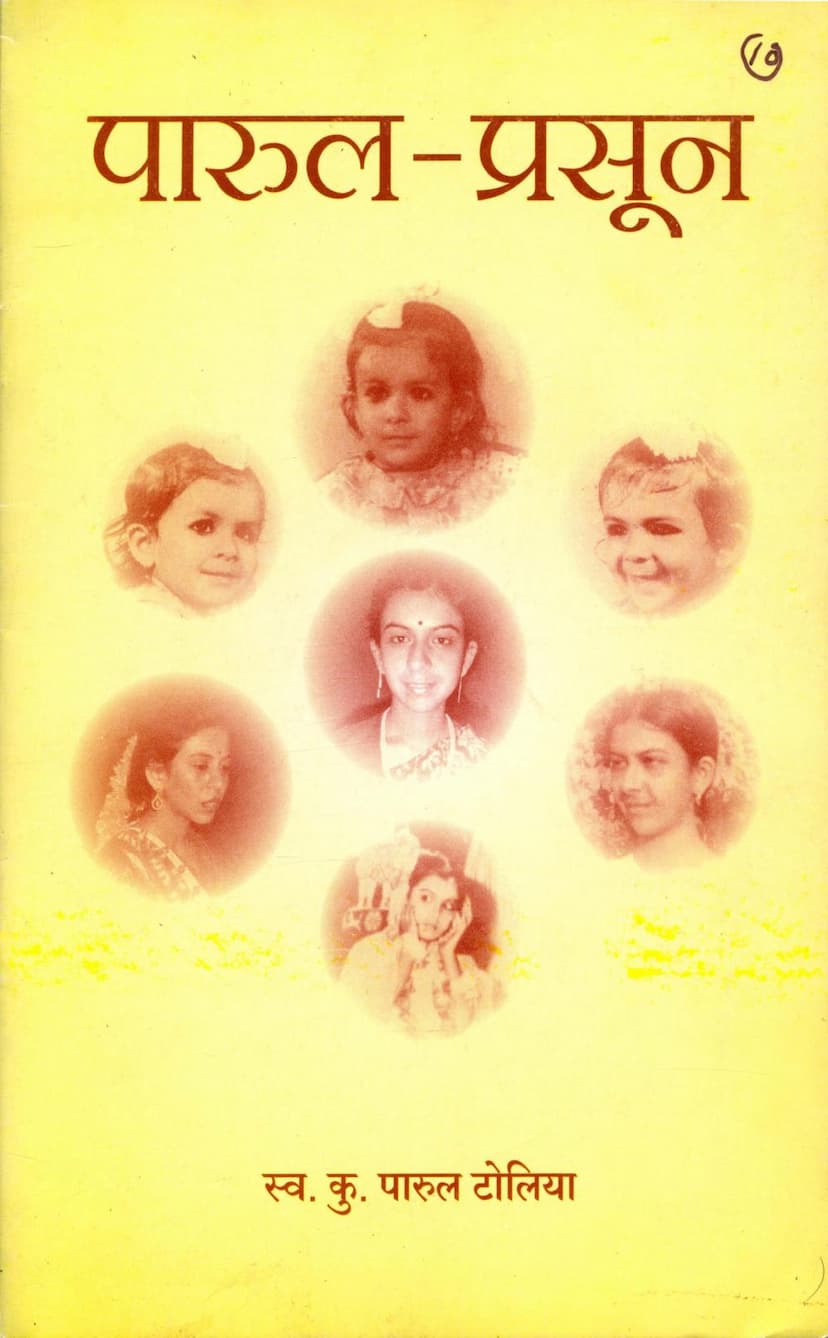Parul Prasun
Added to library: September 2, 2025

Summary
Here's a comprehensive summary of the Jain text "Parul Prasun" by Pratap J Tolia, published by Vardhaman Bharati International Foundation, based on the provided pages:
Parul Prasun: A Tribute to a Blossoming Soul
"Parul Prasun" is a poignant compilation dedicated to the memory of the late Kum. Parul Tolia, a young woman of exceptional talent and spiritual depth, who departed from this world at a tender age. The book, published by Jinabharati and Vardhaman Bharati International Foundation, is a testament to the love and remembrance of her father, Prof. Pratapkumar J. Toliya, and her mother, Smt. Sumitra Toliya.
The Essence of the Book:
The book is a dual offering, reflecting both the literary creations of Parul and the heartfelt tributes and memories of her father, presented under the title "Parul Smriti." It is described as a "father-daughter poetic expression," evoking the spirit of the renowned work "Mangal Mandir Kholo."
Parul's Contributions:
- Poetry: The core of Parul's contribution lies in her eleven poems, presented in the section "Kavyakruti (Paralok ke Alok mein Parul)." These poems, characterized by their sensitivity and spiritual insight, explore themes of:
- Inner Light and Transformation: Poems like "Andhkar hi Bana Alok - Nijghar mein" (Darkness Became Light in My Own Home) and "Nijghar mein" delve into the discovery of inner light and the transformation of perceived darkness into illumination through courage and self-exploration.
- Loneliness and Inner Search: Works such as "Aseema Ekalta" (Limitless Loneliness) and "Punah Tanhai" (Alone Again) express the profound feeling of solitude and the yearning for connection.
- The Nature of Time and Existence: "Samay Sthagan" (Time Halt) is a plea to time itself, seeking moments to cherish, while "Tatasthita" (Detachment) contemplates the ephemeral nature of existence and the desire to remain unbound.
- Aspiration and Self-Discovery: "Swapna Sakarta ki Abhilasha" (Desire for Dream Fulfillment) reflects a quest for understanding and realizing one's dreams, even as the self is lost in the process.
- Existential Reflections: The poems touch upon the human condition, the search for meaning, and the challenges of navigating life's journey, often through metaphors of darkness, light, solitude, and the flow of time.
- A Story: The book includes a short story titled "Ek Anya Meera" (Another Meera), which portrays a character named Meera who finds solace and inner richness in her solitude, contrasting her quiet introspection with the external world's perception. This story highlights the idea of finding one's inner world amidst external neglect.
- A Profound Reflection: "Paralok ke Alok mein Parul" (Parul in the Light of the Otherworld) is a reflective piece, possibly an essay or article, that further explores Parul's spiritual inclinations.
Prof. Pratapkumar Tolia's Tributes:
Under the title "Parul Smriti" (Memories of Parul), Prof. Tolia shares his profound grief, love, and enduring memories of his daughter. These include:
- Dialogue with the Departed Soul: The section "Kaalgati se Pare" (Beyond the March of Time) presents a poignant imagined dialogue between Prof. Tolia and Parul, where Parul asserts her transcendence of time and mortality.
- Heartfelt Poems: Several poems by Prof. Tolia express his pain and enduring love for his daughter. These include "Parul-Pushp" (Parul-Flower), lamenting the premature bloom and harsh impact, and "Jab Shaam Dhale" (When Evening Falls), a comforting presence that fills the void left by her absence.
- Prayers and Aspirations: "Shanti Karo!" (Grant Peace!) is a prayer for universal peace and for Parul's soul, seeking a path of upliftment. "Par Kshijit se" (Beyond the Horizon) and "Mukt-Unmukt" (Free-Unfettered) express the father's perspective of Parul's liberated state and her continued journey beyond the physical realm.
- Cremation-Point Reflections: "Kavitt-Bindu" (Drops of Verse) are poetic reflections on Parul's life, her multifaceted personality, and her spiritual journey, culminating in her ultimate merging with the divine.
- Lingering Memories: "Shesh-Smriti" (Remaining Memory) and "Agam Bol" (Unfathomable Words) touch upon the fading physical presence but the enduring essence of Parul's voice and words.
- Eternal Longing: "Bahe Nirantar" (Flow Continuously) is Parul's final wish, a prayer for a continuous flow of melodious sounds and words in her eternal abode, a wish that resonates with her spiritual aspirations.
The "Parul Prasun" Concept:
The title "Parul Prasun" itself carries a deeper meaning. The word "Prasun" means flower. The "Pra" comes from Pratap (father's name), and "Su" comes from Sumitra (mother's name). The book thus represents the beautiful, fragrant flower born from the love and union of her parents.
Overall Themes and Significance:
"Parul Prasun" is more than just a collection of poems and memories. It is a profound exploration of:
- The Power of Inner Spirituality: Parul's writings emphasize the importance of introspection, self-discovery, and finding peace within.
- The Journey Beyond Physical Life: The book offers a perspective on the soul's journey after death, suggesting transcendence and continued existence.
- The Enduring Bond of Love: It beautifully captures the unbreakable bond between a father and his daughter, even in the face of profound loss.
- The Jain Philosophy of Soul: The text subtly weaves in Jain principles, such as the eternal nature of the soul, the pursuit of inner knowledge, and detachment from worldly illusions.
- Appreciation of Art and Culture: The book also highlights the family's broader engagement with Indian art, music, and literature, as seen in the extensive catalog of publications by both Pratap J Tolia and others associated with Jinabharati.
The book, featuring contributions and evaluations from notable personalities like Dr. Geeta Parikh and Dr. Virendra Kumar Jain, serves as an inspiring tribute to a young soul who, despite her short life, left an indelible mark through her sensitive writings and spiritual inclination.